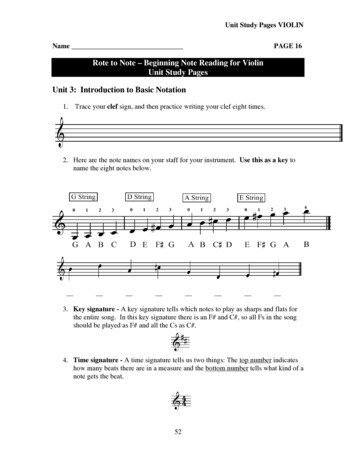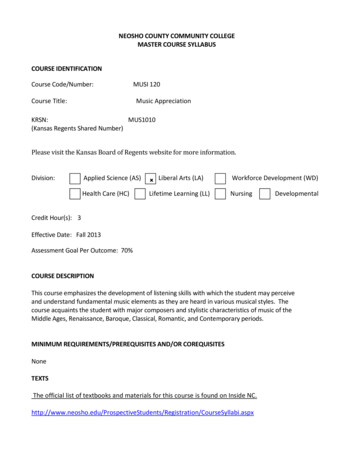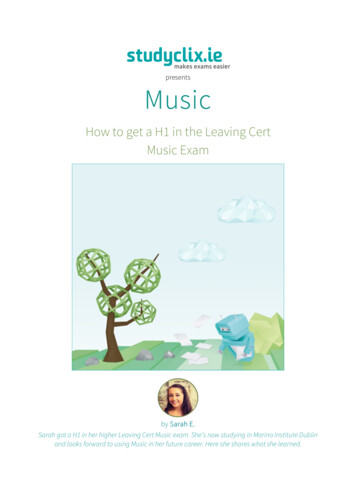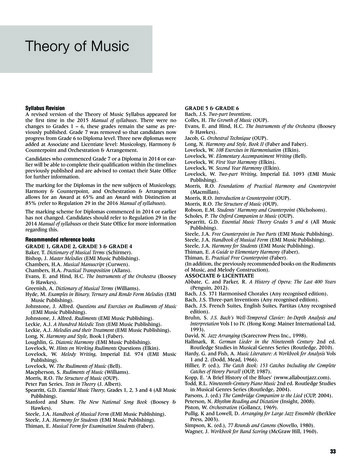
Transcription
Unit Study Pages VIOLINNamePAGE 16Rote to Note – Beginning Note Reading for ViolinUnit Study PagesUnit 3: Introduction to Basic Notation1.Trace your clef sign, and then practice writing your clef eight times.2. Here are the note names on your staff for your instrument. Use this as a key toname the eight notes below.3. Key signature - A key signature tells which notes to play as sharps and flats forthe entire song. In this key signature there is an F# and C#, so all Fs in the songshould be played as F# and all the Cs as C#.4. Time signature - A time signature tells us two things: The top number indicateshow many beats there are in a measure and the bottom number tells what kind of anote gets the beat.52
Unit Study Pages VIOLINUnit 3 (continued)PAGE 175. Rhythm Counting Chart(When the time signature’s4bottom number is 4)34 RHYTHM CHART 4 RHYTHM CHART Quarter note 1 beat Half note 2 beats 11234 1(2)3 Whole note 4 beats(23)(233 (4) Dotted half note 3 beats 1241(2)3(23) 1 14)6. First, write your clef. Next, write a 4/4 time signature. Then, write four quarter notesfor your open A string, followed by a bar line.Unit 3 Practice Assignment1. Complete the written work above.2. Practice French Folk Song three times per practice session, focusing on long bows forthe dotted half notes.3. Practice the D scale and arpeggio 3 times per practice session, focusing on intonation,bow hold and posture.4. Practice two variations of Twinkle per practice session, focusing on posture and bowhold.Student Practice NotesWhat days did you practice?What did you play really well? Why?What aspects of your technique do you think are developing well? What aspects do youneed to really think about?Do you have any questions about Unit 3?53
Unit Study Pages VIOLINUnit 4: Reading and playing the open D and A stringsPAGE 181. On the following staff line, write your clef sign, 4/4 time signature, and at least twomeasures of open D and A quarter notes ( ) and half notes ( ) in any combination thatadd up to four beats per measure. Draw bar lines to separate the measures.2. Dictation: You will hear one measure of 4/4 time played on the open A string, usinghalf notes, quarter notes or a combination. Write your clef sign, and then write what youhear your teacher play.Unit 4 Practice Assignment1. Complete the written work above.2. Practice French Folk Song one time per practice session focusing on long bows.3. Practice the D scale and arpeggio one time per practice session, focusing onintonation.4. Practice one variation of Twinkle per practice session focusing on good posture.5. Song #1– (Title: )Follow the directions on the SongStudy Guide to learn this song pizzicato first, then arco. Try to memorize the song.6. Music reading: Practice the following lines from your method bookStudent Practice NotesDo you notice improvement in your playing with practice?Were you able to memorize Song #1? What helped, or what was difficult?Are you working to improve a particular aspect of your playing?Do you have any questions about Unit 4?54
Unit Study Pages VIOLINUnit 5: Reading notes on the D stringPAGE 191. Name the following D string notes, then draw notes on the second staff.2. Dictation: Write what your teacher plays. You will hear 4 quarter- notes startingon open D and then going to different notes on the D string. The first note iswritten for you.Unit 5 Practice Assignment1.2.3.4.5.Song #1Song #2, following the directions on the Song Study Guide. (Title: )French Folk SongD scale and arpeggioMusic reading: Practice the following lines from your method bookStudent Practice NotesWhat is your favorite song to practice?Do you often start your practice with something difficult and end your session with a funsong? (This is a good habit!)Do you have any questions about Unit 5?55
Unit Study Pages VIOLINUnit 6: Reading notes on the A stringPAGE 201. Name the following A string notes, then draw notes on the second staff.2. Dictation: Write what you hear your teacher play. The first note is written for you.Unit 6 Practice Assignment1.2.3.4.5.Song #3: Follow the directions on the Song Study Guide. (Title: )Review song #2.Review song #1.Review one Twinkle variation, focusing on bow hold and posture.Music reading: Practice the following lines from your method bookStudent Practice NotesAre you able to learn new songs more quickly now because you can read music?Is your playing technique in good shape? Why or why not?Do you have any questions about Unit 6?56
Unit Study Pages VIOLINUnit 7: RhythmsPAGE 211. Continue writing in the counts for the following line:44 12341 (2)342. Rhythm gameYou will need the following supplies:A pencil16 index cards4 or 5 strawsScissorsGlueMake the game:On the rhythm square page at the end of Unit 7, cut along the lines andmake 16 flash cards by pasting pieces on 3x5 index cards.Game directions:1. Choose one time signature (meter), and place at the beginning of your“rhythm song.”2. Use different note values to create the correct number of beats in eachof 2-4 measures. Use straws as bar lines to divide your measures. Usetwo straws at the end of your rhythm song to make the end double barline. (You’ll have to pretend the last straw is thicker.)Now play your song:1. Tap your toe to a steady beat and clap or say the rhythm.2. Play your song pizz. on an open string.3. Play your song arco on an open string.Extra Credit:1. Create a melody to go along with your rhythm.2. Use staff paper on the next page to write your piece down.3. Name your song, and be sure to write your name in the upper rightcorner of the music. (This is where the composer’s name is usuallyfound.)57
Unit Study Pages VIOLINUnit 7 (continued)PAGE 22Enrichment:Use your short song as a “theme” to create a longer song. Develop youridea by playing around with the theme on your instrument. Write downyour composition so you don’t forget it!Extra Credit and Enrichment Staff PaperUnit 7 Practice Assignment1.2.3.4.5.Learn song #4. Follow the Song Study Guide. (Title: )Review French Folk Song. Make it as beautiful as you can.Review and work on songs #1, #2, and #3.Music reading: practice the following lines from your method bookMake and Play the rhythm game.Student Practice NotesIs there a song you now think is easy and fun that you used to think was difficult?What would your string orchestra sound like if everyone played as well as you?Do you have any questions about Unit 7?58
Unit Study Pages VIOLIN24 34 4454 PAGE 2359
Unit Study Pages VIOLINUnit 8: Flash cards with note namesPAGE 24Make your own flash cards for each note of the D Major scale. Cutout the flashcards and glue them to index cards. Write the names ofthe notes on the back of the cards. Keep them in your notebook.60
Unit Study Pages VIOLINPAGE 25Unit 8 Practice Assignment1.2.3.4.Make the flash cards.Review songs #1, #2, #3 and #4 to refine. Focus on your sound.Practice the D scale and arpeggio.Music reading: practice the following lines from your method bookStudent Practice NotesAre you in the good habit of practicing every day?Do you look forward to practicing?What is the most difficult part of practicing? (Often it’s getting out the instrument.)Do you have any questions about Unit 8?61
Unit Study Pages VIOLINPAGE 26thUnit 9: Reading 8 notes1. Continue writing in the counts for the following line:12 341 2. Compose your own song using a combination of eighth, quarter, and half notes.Use notes from the D scale.Unit 9 Practice assignment1.2.3.4.Review all of your songs.Music reading: practice the following lines from your method bookPractice the D scale and arpeggioPractice Twinkle with eighth notes.Student Practice NotesHave you purchased music books to practice solos?Do you ever practice more than what is assigned for each unit?Do you have plans to keep playing over the summer?Do you have any questions about Unit 9?62
Are you able to learn new songs more quickly now because you can read music? Is your playing technique in good shape? Why or why not? Do you have any questions about Unit 6? Unit 6 Practice Assignment 1. Song #3: Follow the directions on the Song Study Guide.










